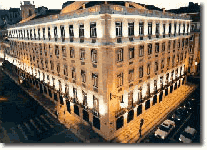Japan changes name of Iwo Jima
 TOKYO - Japan has returned to using the prewar name for the island of Iwo Jima — site of one of World War II's most horrific battles — at the urging of its original inhabitants, who want to reclaim an identity they say has been hijacked by high-profile movies like Clint Eastwood's "Letters from Iwo Jima." The new name, Iwo To, was adopted Monday by the Japanese Geographical Survey Institute in consultation with Japan's coast guard.
TOKYO - Japan has returned to using the prewar name for the island of Iwo Jima — site of one of World War II's most horrific battles — at the urging of its original inhabitants, who want to reclaim an identity they say has been hijacked by high-profile movies like Clint Eastwood's "Letters from Iwo Jima." The new name, Iwo To, was adopted Monday by the Japanese Geographical Survey Institute in consultation with Japan's coast guard.Surviving islanders evacuated during the war praised the move, but others said it cheapens the memory of a brutal campaign that today is inextricably linked to the words Iwo Jima. Back in 1945, the small, volcanic island was the vortex of the fierce World War II battle immortalized by the famous photograph by Joe Rosenthal of The Associated Press showing Marines raising the American flag on the islet's Mount Suribachi.
Retired Marine Maj. Gen. Fred Haynes, who was a 24-year-old captain in the regiment that raised the flag on Mount Suribachi, was surprised and upset by the news. "Frankly, I don't like it. That name is so much a part of our tradition, our legacy," said Haynes. Haynes, 87, heads the Combat Veterans of Iwo Jima, a group of about 600 veterans that travels to the island every year for a reunion. He is working on a book about the battle called "We Walk by Faith: The Story of Combat Team 28 and the Battle of Iwo Jima." He doesn't plan to change the name. "It was Iwo Jima to us when we took it," said Haynes. "We'll recognize whatever the Japanese want to call it but we'll stick to Iwo Jima." Before the war, the isolated spit of land was called Iwo To — pronounced "ee-woh-toh" — by the 1,000 or so people who lived there. In Japanese, that name looks and means the same as Iwo Jima — Sulfur Island — but it has a different sound. The civilians were evacuated in 1944 as U.S. forces advanced across the Pacific. Some Japanese navy officers who moved in to fortify the island mistakenly called it Iwo Jima, and the name stuck. After the war, civilians weren't allowed to return and the island was put to exclusive military use by both the U.S. and Japan, cementing its identity.
Locals were never happy the name Iwo Jima took root. But the last straw came this year with the release of Eastwood's "Letters from Iwo Jima" and "Flags of Our Fathers," war films that only reinforced the misnomer. In March, Ogasawara, the municipality that administers Iwo To and neighboring islands, responded by adopting a resolution making Iwo To the official name. Ogasawara residents and descendants of Iwo To evacuees petitioned the central government to follow suit. "Though we're happy for Iwo To, which has been forgotten by history, the islanders are extremely grieved every time they hear Iwo To referred to as Iwo Jima," the local Ogasawara newspaper quoted the resolution as saying of the Eastwood movies. The government agreed; an official map with the new name will be released on Sept. 1. Still, Iwo Jima is the only name that clicks with most Japanese who aren't from the remote island chain, some 700 miles southeast of Tokyo in the Pacific Ocean. Even some Japanese war veterans, like 84-year-old Kiyoshi Endo, who heads an association commemorating soldiers killed in the battle, feel uncomfortable about the switch. "Naval maps have long used the name Iwo Jima," Japan's Sankei newspaper quoted Endo as saying. "We should respect that history." Today Iwo To's only inhabitants are about 400 Japanese soldiers. The 1945 battle for Iwo Jima pitted some 100,000 U.S. troops against 22,000 Japanese deeply dug into a labyrinth of tunnels and trenches. Nearly 7,000 Americans were killed capturing the island, and fewer than 1,000 of the Japanese survived. The Americans occupied the island after the war, and returned it to Japanese jurisdiction in 1968. The U.S. Navy still uses an airstrip on the island to train pilots who operate from aircraft carriers (fonte: Associated Press Writer Lily Hindy in New York contributed to this report)






































<< Página inicial